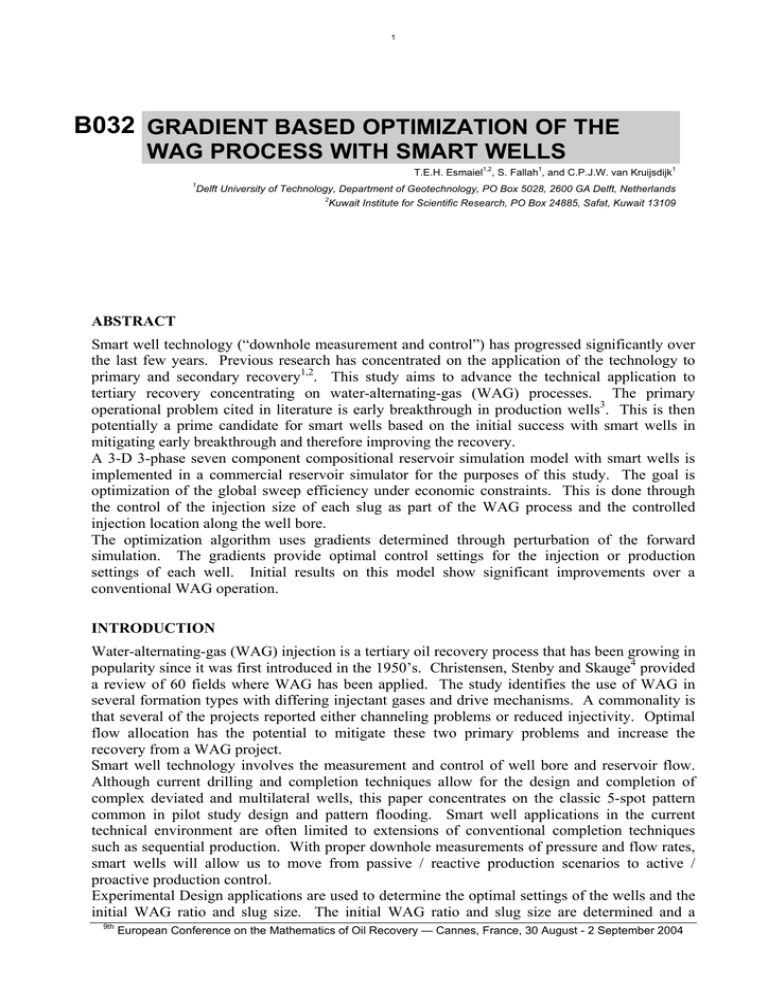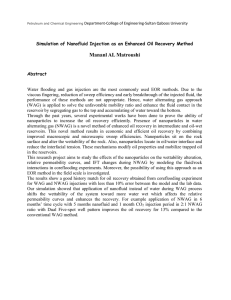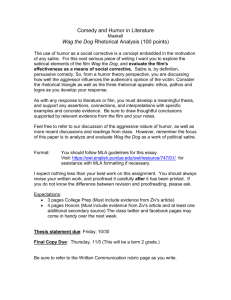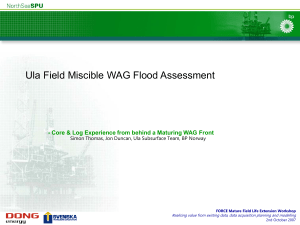B032 GRADIENT BASED OPTIMIZATION OF THE WAG PROCESS WITH SMART WELLS
advertisement

1 B032 GRADIENT BASED OPTIMIZATION OF THE WAG PROCESS WITH SMART WELLS 1,2 1 T.E.H. Esmaiel , S. Fallah , and C.P.J.W. van Kruijsdijk 1 1 Delft University of Technology, Department of Geotechnology, PO Box 5028, 2600 GA Delft, Netherlands 2 Kuwait Institute for Scientific Research, PO Box 24885, Safat, Kuwait 13109 ABSTRACT Smart well technology (“downhole measurement and control”) has progressed significantly over the last few years. Previous research has concentrated on the application of the technology to primary and secondary recovery1,2. This study aims to advance the technical application to tertiary recovery concentrating on water-alternating-gas (WAG) processes. The primary operational problem cited in literature is early breakthrough in production wells3. This is then potentially a prime candidate for smart wells based on the initial success with smart wells in mitigating early breakthrough and therefore improving the recovery. A 3-D 3-phase seven component compositional reservoir simulation model with smart wells is implemented in a commercial reservoir simulator for the purposes of this study. The goal is optimization of the global sweep efficiency under economic constraints. This is done through the control of the injection size of each slug as part of the WAG process and the controlled injection location along the well bore. The optimization algorithm uses gradients determined through perturbation of the forward simulation. The gradients provide optimal control settings for the injection or production settings of each well. Initial results on this model show significant improvements over a conventional WAG operation. INTRODUCTION Water-alternating-gas (WAG) injection is a tertiary oil recovery process that has been growing in popularity since it was first introduced in the 1950’s. Christensen, Stenby and Skauge4 provided a review of 60 fields where WAG has been applied. The study identifies the use of WAG in several formation types with differing injectant gases and drive mechanisms. A commonality is that several of the projects reported either channeling problems or reduced injectivity. Optimal flow allocation has the potential to mitigate these two primary problems and increase the recovery from a WAG project. Smart well technology involves the measurement and control of well bore and reservoir flow. Although current drilling and completion techniques allow for the design and completion of complex deviated and multilateral wells, this paper concentrates on the classic 5-spot pattern common in pilot study design and pattern flooding. Smart well applications in the current technical environment are often limited to extensions of conventional completion techniques such as sequential production. With proper downhole measurements of pressure and flow rates, smart wells will allow us to move from passive / reactive production scenarios to active / proactive production control. Experimental Design applications are used to determine the optimal settings of the wells and the initial WAG ratio and slug size. The initial WAG ratio and slug size are determined and a 9th European Conference on the Mathematics of Oil Recovery — Cannes, France, 30 August - 2 September 2004 2 Plackett-Burman5 screening design is used to screen the initial set of variables and decide which well bore sections contributed most to the early breakthrough problems. A D-optimal design is used at each time step to determine the set of runs to perturb the variables and determine the gradients for optimization. A proxy model is built and optimized with respect to the opening and closing of completions at each time step. Initial results on this model show significant scope for the application of smart well technology to the WAG process. The optimization technique applied requires a simulation model that is fast enough for multiple runs and accurate enough to produce valid results. WAG The tertiary recovery process known as WAG is a combination of the two secondary recovery processes of water flooding and gas injection. The WAG process was proposed originally to aim for the ideal system of oil recovery: improvements in macroscopic and microscopic sweep efficiency at the same time. The water is used to control the mobility of the gas as can be seen in equations 1 and 2. The cyclic nature of the WAG process causes an increase in water saturation during the water injection half cycle and a decrease of water saturation during the gas injection half cycle. This process of inducing cycles of imbibition and drainage causes the residual oil saturation to WAG to be typically lower than that of water flooding and similar to those of gas flooding. kw µ w (1) fw = k w µ w + ko µ o + k g µ g kg µ g fg = (2) k w µ w + ko µ o + k g µ g The oil recovery factor can be described by two factors that are the macroscopic sweep efficiency and the microscopic sweep efficiency. Further more the macroscopic sweep efficiency is defined by the horizontal and the vertical sweep efficiencies. This can be formulated as: R f = Ev .Eh .Em (3) M= krg µ g kro µ o (4) ⎛ νµ o ⎞ ⎛ L ⎞ Rv g = ⎜ (5) ⎟⎜ ⎟ ⎝ kg ∆ρ ⎠ ⎝ h ⎠ Literate on the WAG process typically discusses two major management parameters that affect the economics of a WAG project. These operational aspects are the half-cycle slug sizes and the WAG ratio. The two major problems faced are early breakthrough and injectivity losses. It is therefore proposed that the third parameter to be studied is the operation of the smart wells. The two most common distinctions in the classification of the WAG process are miscible WAG injection and immiscible WAG injection. Miscible WAG injection occurs when the reservoir is above the minimum miscibility pressure (MMP) and is immiscible when below the MMP. In this study the initial reservoir pressure is just above the MMP and therefore often moves in and out of miscibility in part or all of the reservoir. 3 RESERVOIR MODEL The reservoir model is 2,641 by 2,641 by 144 feet, modeled 19 by 19 grid blocks aerially and 26 in the vertical. An up scaled model with 4 grid blocks in the vertical is used for the design simulation and the results applied to the fine grid. A standard 5-spot pattern with a central injector and 4 producers is used with all sides bounded by no flow boundaries. The reservoir model is implemented in a commercial reservoir simulator to model the WAG process. A detailed fluid description with the 7 components describes the oil and gas. An initial WAG ratio of 1:1 is used with 3 months per injection phase. Described in the WAG introduction, two primary problems faced in WAG processes are early breakthrough and loss of injectivity. The economic constraints placed on the wells are a maximum water cut of 0.5 stb/stb and a maximum GOR of 5 Mscf/stb at which point the well is shut-in. The wells are also tested every 100 days and connections can be reopened if the test shows the well can operate below the GOR and water cut constraints. This initial model with a 7% HCPV slug size and conventional wells experienced major breakthrough problems forcing the wells to be shut in, resulting in lost production. DESIGN Design Basics The computational demands of the reservoir simulator results in the need to reduce the number of runs to use to train the proxy model. Design of Experiments6,7 (DOE) and the related technique of Response Surfaces are used to select the set of runs to perform. DOE selects experiments to maximize the information gained from each experiment. The design provides a set of input values for the factors in the experiment. A sample 2 level 3 parameter full factorial design can be seen in Table 1 resulting in 23 = 8 simulation runs or experiments. The factor levels -1 and 1, as well as 0 if a 3 level design are used representing the scaled and normalized minimum, maximum and mean values respectfully. Plackett-Burman screening design Initially a large number of factors must be screened at each time step. These are the status of each valve for each well at the time step being optimized. To screen a large number of parameters the interaction terms are confounded with the new main effects. These new saturated designs would then have 2k runs. Plackett and Burman provided a new way to fractionalize the full factorial yielding designs where the numbers of runs are 4*k rather than 2k. D-Optimal Design A D-optimal design attempts to minimize the average size of the variance matrix by minimizing the average eigen-value. A maximization of D-efficiency results in finding a design where the factor effects are maximally independent. D-efficiency = 100 * (|X'X|1/p/n) (6) Where X is the regression matrix, p is the number of parameters in the model, and n is the number of observation point or simulations. Optimal designs offer significant advantages over classic experimental designs. A D-optimal design can be modified to allow the number of simulation the experimenter wants. Classic designs typically are not as flexible in allowing the experimenter to control the parameters. The design can also be augmented to add additional runs if the experimenter feels they are necessary. This is done while maintaining the optimality given the set of runs already performed therefore maximizing the additional information gained. Additionally the design is optimized for the response surface model the data will be fit to. Response Surface Modeling 9th European Conference on the Mathematics of Oil Recovery — Cannes, France, 30 August - 2 September 2004 4 The response surface models8 incorporate the effects of the input parameters on the response. In essence these models are the proxy models being sought after in this paper. The second-order model in general form is given as (Myers and Montgomery, 1995): k k η = β o + ∑ β j x j + ∑ β jj x 2j + ∑ ∑ β ij xi x j i< j j =1 j=2 (7) It includes a constant, linear effects, single-term quadratic effects, and two-term interactions. Response surfaces are 3D visualizations of the response surface model. These surfaces allow a visualization of two of the parameters effects on the observation. This is the proxy model optimized with respect to the valve settings at each time step. Significance testing of the models is performed in order to validate the results. Standard R2 regression analysis is performed on the resulting model. This provides the fit of the model to the input data to the training set. Additionally, an adjusted R2 taking into account the number of terms in the model is provided as: (8) R2adj = 1 – (1 – R2)*(n – 1)/(n – p) The statistical significance of the values is tested by the testing of a null hypothesis. The plausibility of the null hypothesis is quantified by means of the probability P-value. METHODOLOGY The first step in the scope of the work is deciding the problem that is to be addressed. The problem being addressed is the optimal recovery of oil under the economic constraints imposed on the wells. The first step taken in addressing the issue looks at sensitivity issues of the WAG process9. This work was performed on the same model used in this study. Gas breakthrough problems occurred in all the simulation runs and loss of water injectivity occurred in a significant number of the runs. The first step in the optimization is determining the optimum WAG parameters and injection location along the well bore at the start of the project. This is done by setting up a d-optimal design with 6 parameters that include the WAG ratio, slug size, and status of each completion along the well bore. All production wells are placed on a reactive control mode at this time. The optimum WAG parameters determined at this stage remain constant throughout the simulation. Additionally 4 test simulations were done at coded parameter setting values corresponding to 0.5 and +0.5 for the WAG ratio and slug size to validate the results. It is important to note that the test runs are within the ranges of the design but not at the same levels as the training observations. The ranges for the WAG ratio and slug size and their corresponding coded values can be seen in Table 2. The parameters are coded and scaled such that the low value is coded to -1, the median to 0 and the maximum value to +1. There are then some assumptions made that all runs can be performed at any combination of these settings. If this were not true the design could be modified with constraints. At each subsequent time step a Plackett-Burman screening design, encompassing all completions from all 5 wells, is ran and analyzed to determine which segments need to be studied in further detail. The rational behind this can be seen in Table 3 that shows how the number of regression parameters and the number of simulation runs in a 3 level full factorial design. Multiple D-optimal designs were set up with different numbers of parameters and runs for these time steps. The simulations are performed and a response surface model is generated for the well setting at that time step. The current time step was then optimized with later time steps operating under reactive control. 5 SCOPE FOR IMPROVEMENT Without seeing an increase in the expected value of the project due to the smart wells there would be little reason to create a proxy model. Figure 1 shows the improvement of the project oil recovery and the gas production total versus several base case scenarios. The optimized case showed a small increase in gas production along with the significant increase in oil production. These base case scenarios provided for comparison are all using the same well configuration and constraints and intend to show the value of the different aspects of the process. Base Case 1 is a water flood performed on the field. Case 2 is a gas flood performed on the field. Case 3 is a WAG process with the original WAG parameters used. Case 4 is the optimized case with smart wells operated under the proactive controls determined in this study. Figure 2 shows the oil recovery curves for the four cases. Note that the optimized case extends the peak production time by over 2 years compared to the base WAG project. Control of the wells has increased oil production by over 58% with respect to the base WAG process while still operating under all the production and economic constraints. The full scope of improvement in the NPV was also analyzed. The NPV is a function of the oil produced as well as the gas and the water both injected and produced. This means the improvement is a result of mitigating gas and water production in conjunction with the improved sweep efficiency although it must be noted that water production was minimal at all stages All the positives are seen in this optimization except that a few hundred extra barrels of water were produced over the entire time span of the project. This includes delayed gas breakthrough, and extended peak oil production as well as larger cumulative oil production and lower cumulative gas production. PROXY MODEL Response surfaces are a visualization tool to represent the response surface models. These surfaces are said to be useful to see the interaction of two parameters but this must be done with caution. The surfaces only show two parameters at a time and are therefore not practical when performing a multi-parametric optimization or sensitivity analysis. For visualization purposes sample response surfaces are provided in Figures 3 & 4. These figures are provided in a 3D surface and a contour map. Regression models were created for various different designs and different time steps in the optimization process. Figure 3 shows a sample response surface of the WAG ratio and the slug size plotted versus the oil recovery. Figure 4 shows a sample response surface of the WAG ratio and the slug size plotted versus the NPV. The optimization was done including the valve setting but this figure demonstrates how parameters are dependant on each other and optimized in conjunction with each other to maximize the recovery. Regression analysis is often limited to seeing that R2 is near one and then saying everything is fine. Although the trend is not evident in the R2 analysis it is evident in the R2adj and R2test that the model is a valid proxy for the recovery. The NPV of the smart well is primarily defined by the allowable injection / production rate and the price of the oil. The geologic and fluid parameters that caused major problems for the conventional well have a minimal effect on the smart well. The value gained from this will be investigated in further studies. CONCLUSIONS • • • The proxy model was able to adequately represent the recovery and NPV calculations computed with the flow simulator. The proxy model allowed the WAG process to be optimized. Smart well technology offers various benefits over conventional wells. 9th European Conference on the Mathematics of Oil Recovery — Cannes, France, 30 August - 2 September 2004 6 • Flow rates were optimized to show significant improvement in the recovery. • Capital Expenditures and other more detailed economic considerations must be considered before a final analysis the value of the project can be fully analyzed ACKNOWLEDGEMENTS This work was performed at Delft University of Technology through financial support from Kuwait Institute for Scientific Research, National Iranian Oil Company. REFERENCES 1. Brouwer, D.R., Jansen, J.D., van der Starre, S., and van Kruijsdijk, C.P.J.W.: “Recovery Increase through Water Flooding using Smart Well Technology,” paper SPE 68979 presented at the 2001 SPE European Formation Damage Conference, The Hague, The Netherlands, May 21-22. 2. Dolle, N., Brouwer, D.R., and Jansen, J.D.: “Dynamic Optimization of Water Flooding with Multiple Injectors and Producers using Optimal Control Theory,” Proc. XIVth International Conference on Computational Methods in Water Resources, Delft (2002) 23-28. 3. Rogers, J.D., Grigg, R.B., “Ä Literature Analysis of the WAG Injectivity Abnormalities in the CO2 Process”, paper SPE 73830. 4. Christensen, J.R., Stenby, E.H., Skauge, A., “A Review of WAG Fiend Experience”, paper SPE 71203. 5. Plackett, R.L., Burman, J.P., “The Design of Optimum Multifactorial Experiments”, Biometrika, Vol. 33, Issue 4, June 1946. 6. Box, G.E.P., Hunter, W.G., Hunter, J.S., “Statistics for Experimenters”, John Wiley & Sons, 1978. 7. Box, G.E.P., Draper, N.R., “Experimental Model-Building and Response Surface”, John Wiley & Sons, 1987. 8. Myers, R.H., Montgomery, D.C., “Response Surface Methodology”, John Wiley & Sons, 1995. 9. Fallah, S, et.al., “WAG Study: DOE Bases Sensitivity Analysis and Matrix Fracture Interaction Up-scaling”, paper ECMOR 2004. 10. Aziz, K., and Settari, A.: “Petroleum Reservoir Simulation”, Elsevier Applied Science Publishers 1986. 11. Green, J.W., Willhite, G.P., “Enhanced Oil recovery”, SPE Textbook Vol. 8, 1998. TABLES Run 1 Run 2 Run 3 Run 4 Run 5 Run 6 Run 7 Run 8 Factor A 1 1 1 1 -1 -1 -1 -1 Factor B 1 1 -1 -1 1 1 -1 -1 Table 1: Sample coded 2 level 3 parameter full factorial design. Factor C 1 -1 1 -1 1 -1 1 -1 7 Coded Value WAG Ratio Slug Size % Valve Setting Minimum -1 0.2 4 Shut Median 0 1 7 N/A Maximum 1 5 10 Open Table 2: Factor setting for the WAG Ratio, water and gas slug sizes, and valve settings. Number Parameters 4 5 6 8 10 Regression Parameters 15 21 28 45 66 3 Level Full Factorial 81 243 729 6561 59049 Table 3: This table shows why a full factorial study is not feasible and an optimal design must be implemented. FIGURES 4.0 3.5 3.0 Oil Production Total Gas Production Total 2.5 2.0 1.5 1.0 0.5 0.0 Water Flood Gas Flood WAG Base WAG Optimized Figure 1: Field oil and gas production normalized totals for the 4 comparison cases. 9th European Conference on the Mathematics of Oil Recovery — Cannes, France, 30 August - 2 September 2004 8 1.4E+06 1.2E+06 Oil ProductionTotal (stb) 1.0E+06 Water Flood 8.0E+05 Gas Flood WAG Base 6.0E+05 WAG Optimized 4.0E+05 2.0E+05 0.0E+00 0 1 2 3 4 5 6 7 8 9 10 11 Time (yrs) Figure 2: Oil production curves for the 4 comparison cases. Figure 3: A 3D and 2D Response Surface of the Cumulative oil production versus the water and gas slug size. Figure 4: A 3D and 2D Response Surface of Net Present Value versus the water and gas slug size.




